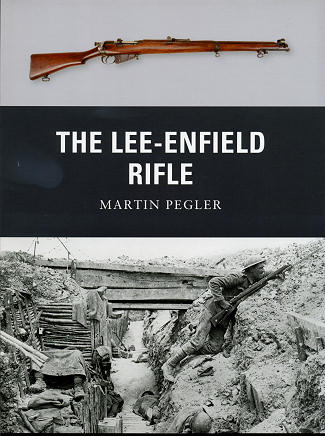 Number
17
in their 'Weapons' book series, Osprey has chosen the Lee-Enfield rifle. The
Lee-Enfield was an early bolt action rifle that received a lot of criticism from
British shooters. These were men who, as often happens, were used to things
'being the way they are', and not open to innovation or change. Sound familiar?
Number
17
in their 'Weapons' book series, Osprey has chosen the Lee-Enfield rifle. The
Lee-Enfield was an early bolt action rifle that received a lot of criticism from
British shooters. These were men who, as often happens, were used to things
'being the way they are', and not open to innovation or change. Sound familiar?
The Lee-Enfield was also able to handle a multi-round
magazine, which seriously improved the soldier's ability to fire of a lot of
rounds. Interestingly, there was some official resistance to this as it was felt
that soldiers would simply waste ammunition. The development of this rifle also
came when new propellants were available to replace the old black powder
bullets. This meant a properly rifled bore was needed as well as a somewhat more
hefty construction to take care of the higher rate of fire the gun could
provide. It changed the way the British Army used infantry as no longer was the
two or three deep firing line required so that earlier shooters could reload. To
add to the lucky happenstance, this additional power of the propellant meant
that a smaller round could be used, and this was the start of a long run of .303
ammunition, that was used in just about everything from rifles to machine guns.
Of course, as good as the Lee-Enfield was, it was not a
superior long range rifle. This was in part because the barrel was almost
entirely encased in the wood stock. Even then, gun experts knew that the heating
and cooling of the wood would cause small 'warps' in the barrel, throwing off
any previous sighting. There was more clamor when it was decided to build a
short barrel version, the SMLE. This not only reduced weight, but further
compromised range. Fortunately, it was a very good weapon for trench warfare,
where the enemy was not a long distance away and it proved to be useful in the
trenches, where the longer rifle would simply get hung up in things as it was
wielded about.
So successful was the Lee-Enfield, that it was used
throughout WWI, the interwar period, WWII, Korea and into the 1950s. Some uses
of the gun were still relevant until the early 1980s when the last was retired
from British Army use. Even today, it is not unusual to find the Lee-Enfield in
use by not only armies, but by opposition groups around the world.
It is a rifle that, despite its peculiarities and
difficulties, was to evolve as a real work-horse of a gun that found a lot of
folks using it and using it well.
Author Martin Pegler tells us the story of the
Lee-Enfield from its inception, through various modification, trials and
tribulations until it was finally replaced by a more modern assault rifle. Like
all books in this series, it is accompanied by period and modern photos of the different
variations and of those who carried the gun into combat. I am pleased to notice
that not much space has been taken on 'how to fire and maintain' the rifle as I
have seen in some other books in this series. To me, this is of minimal interest
and should be treated as a footnote rather than a full section.
It all makes for another fine book and if you are
interested in weapons, then this book would make a fine addition to your
library.
April 2012
For more on the complete line of Osprey books,
visit www.ospreypublishing.com
or contact them at Osprey Direct, PO Box 140, Wellingborough, Northants,
NN8 2FA, UK. In the US, it is
Osprey Direct at 44-02 23rd St, Suite 219, Long Island City, NY 11101., where you can
get a catalogue of available books.
If you would like your product reviewed fairly and quickly, please
contact
me or see other details in the Note to
Contributors.
 Number
17
in their 'Weapons' book series, Osprey has chosen the Lee-Enfield rifle. The
Lee-Enfield was an early bolt action rifle that received a lot of criticism from
British shooters. These were men who, as often happens, were used to things
'being the way they are', and not open to innovation or change. Sound familiar?
Number
17
in their 'Weapons' book series, Osprey has chosen the Lee-Enfield rifle. The
Lee-Enfield was an early bolt action rifle that received a lot of criticism from
British shooters. These were men who, as often happens, were used to things
'being the way they are', and not open to innovation or change. Sound familiar?